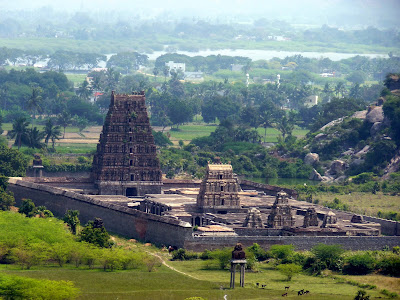 Our Tamil Nadu Hindu Temple blog continues in Tirunavannamalai (which I visited on a solo day-trip), home to the massive Arunachaleswar Temple. It's one of the largest and holiest temples in India, covering some 10 hectares of land. The temple is dedicated to Shiva in his fire incarnation, to commemorate the legend that Shiva appeared as a column of fire on nearby Mount Arunachala. The temple grounds and surroundings were especially crowded and chaotic, but as I approached into the inner depths of the temple (where pictures unfortunately were not allowed), the atmosphere became increasingly more solemn and intense, with long lines of worshipers quietly waiting to make offerings and to be blessed. My friendly driver did the best he could to guide me through the temple and show me all of the various rituals involved - mainly through hand gestures, given his limited English and my even more limited (i.e., non-existent) Tamil. (To give you an idea of the level of our communications, on our way to the temple, he stopped the car and when I asked him why, he said succinctly, “urine.”) Despite the language gap, it was probably the closest I got on our trip to seeing Hindu worship in action.
Our Tamil Nadu Hindu Temple blog continues in Tirunavannamalai (which I visited on a solo day-trip), home to the massive Arunachaleswar Temple. It's one of the largest and holiest temples in India, covering some 10 hectares of land. The temple is dedicated to Shiva in his fire incarnation, to commemorate the legend that Shiva appeared as a column of fire on nearby Mount Arunachala. The temple grounds and surroundings were especially crowded and chaotic, but as I approached into the inner depths of the temple (where pictures unfortunately were not allowed), the atmosphere became increasingly more solemn and intense, with long lines of worshipers quietly waiting to make offerings and to be blessed. My friendly driver did the best he could to guide me through the temple and show me all of the various rituals involved - mainly through hand gestures, given his limited English and my even more limited (i.e., non-existent) Tamil. (To give you an idea of the level of our communications, on our way to the temple, he stopped the car and when I asked him why, he said succinctly, “urine.”) Despite the language gap, it was probably the closest I got on our trip to seeing Hindu worship in action.



Not far from Tirunavannamalai is the Gingee Fort, a sprawling array of temples, turrets, towers, old stone buildings, and military fortifications built from the 13th to the 16th centuries. The fort is set amidst a picturesque landscape of thick green forests, rice paddies and farm fields, craggy mountains and rocky hills – and stunning views. I ran into a bunch of friendly Indian tourists and school groups who were eager to practice their English and make new friends – and some less-than-friendly little monkeys on the prowl for fruit and snacks. Initially, my driver happily signaled to me that he was coming along to tour the site, but a few minutes into the hot, steep ascent, he motioned that he was going back to the entrance to wait for me in the car, where I found him snoring loudly upon my return.




















Our next temple stop was Thanjavur, capital of the ancient Chola Empire and home to my personal favorite of all the temples that we saw in Tamil Nadu. Built in the 11th century, the Brihadishwara Temple, a UNESCO World Heritage Site, is an architectural landmark that beautifully demonstrates the close cultural connection between southern India and southeast Asia. At the height of their reign, the Cholas expanded their empire to Sri Lanka, Indonesia, Cambodia, Thailand and Vietnam and in the process triggered a cross-pollination of art, architecture, culture and religion that lasted for centuries and the effects of which can still be seen and felt today. Bali remains a Hindu island thanks to the influence of the Cholas and the tan sandstone Brihadishwara Temple in Thanjavur would not look out of place among the Khmer temples of Angkor Wat in Cambodia. The temple's detailed stonework and colorful murals are beautiful, there's a great sense of harmony in the temple's design, and the weight of history is palpable. A short tuk-tuk ride from the temple, there's an old decaying palace overtaken by weeds with elaborate decorations, stately hallways and picturesque courtyards. All in all, Thanjavur was a fantastic place to spend a day being a tourist.
 |
| At the royal palace in Thanjavur |
For those of you who crave more Hindu temple action, the dramatic final chapter of our Tamil Nadu temple trilogy is coming soon to a computer screen near you! Ganesh, Shiva, Talia, and Jeremy have already signed on to starring roles. Get your buttered popcorn ready...




























No comments:
Post a Comment